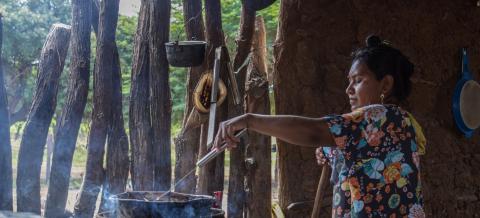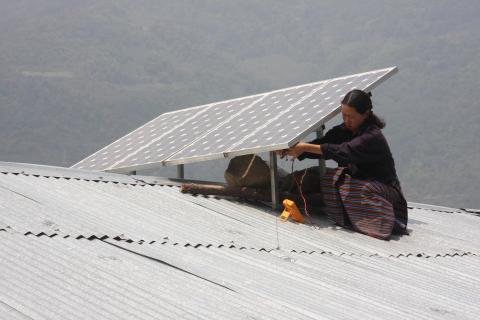
Building on Kyiv: Next steps for gender and resource governance
Building on Kyiv: Next steps for gender and resource governance
Rebecca Iwerks is the Director of Capacity Development at the Natural Resource Governance Institute (NRGI) and works to develop curriculum to help actors translate research into effective policy change.
The changes to the EITI Standard approved by the EITI Board in Kyiv last week represent a significant step towards making natural resource governance more gender-inclusive. The EITI’s 52 member states are now required to consider gender participation in their multi-stakeholder group, disclose gender disaggregated data, and plan their dissemination of that data to respond to the different ways that men and women access information. While these are ground breaking measures, Executive Director of Publish What You Pay Elisa Peters reminds us that they are just the beginning of a long path towards equitable resource governance.
On International Women’s Day, I want to highlight why these changes to the EITI Standard are important and offer a few next steps. The new provisions in the EITI standard address three areas: how to increase women’s participation in decision-making processes; what data should be disclosed; and how to disclose data in a way that makes it accessible a wide audience. These provide a useful framework to examine what is being done to promote gender inclusion and the next actions countries can take.
Prioritising space for participation
From consultations on environmental assessments to participation in EITI multi-stakeholder groups (MSGs), men often outnumber women in resource governance discussions and decision-making. This matters because men and women often experience the impacts of extraction differently and we find that the views of how women are impacted are often missing from resource governance discussions. For example, women are more likely to be impacted by changes in water access, while men are more likely be directly employed by an extraction site. For resource governance policies to respond to the needs of a country’s population, including the half who are female, it is important that there is a space where a variety of views are considered.
The EITI Standard will now require all countries to consider gender when forming their multi-stakeholder groups. MSGs should be aware that the UN and other international bodies consider 30% representation necessary for critical mass of influence. MSGs can also take proactive steps to decrease barriers for participation, which they can learn about by engaging directly with women’s groups and gender ministries to learn from gendered participation in other aspects of government. In taking these steps, MSGs need to understand that just because women are in the room, it does not mean that they can participate equally. In a study on women’s participation in Environmental Impact Assessments in Myanmar, Spectrum found that the number of women present at a consultation meeting did not necessarily correlate with input from those women. It’s important to support women with the information, skills and conceptual clarity to contribute meaningfully to conversations. Moreover, all members of the MSGs – women and men – should be trying to find ways to represent the needs of the entire population.
Disclosing data that informs gendered resource governance policies
At NRGI, we think a fundamental step towards creating more gender-informed resource governance involves making sure we have access to the right data. We talk about this data in terms of three categories: data with gendered impact, gender disaggregated or altered data, and gender-neutral data.
Data with gendered impact is data that is unlikely to be changed, but that is important because of its potential to inform gendered policy-making. The recent changes to the EITI Standard related to contract transparency and project-level reporting are strong examples. As Oxfam explains, women’s groups in the Dominican Republic have been asking questions about what revenues their municipality should expect as a result of a specific project. The data in this case is not disaggregated by gender, but its importance can have a high impact on women – without this information, women could not effectively advocate for how their community should benefit from extraction. By matching project-level information with disclosed contracts – these being new requirements of the EITI Standard – women’s groups will be in a much stronger position to demand change.
Gender disaggregated or altered data is data where something different needs to be disclosed to inform policy-making. For example, the EITI now requires all labour data to be disaggregated by sex. Beyond this data point, there is a lot of room for innovation on what data to disaggregate based on the policy issues that countries want to better understand. For example, the MSG in Malawi committed to having gender disaggregated data about social-economic impacts in their EITI workplan, and Kenya and Mexico already have laws requiring the same in all impact assessments. Countries concerned about the gendered impact of local content, such as Uganda, have created efforts to track the gendered participation in training programs.
Making data accessible for everyone
The goal of data disclosure is to create better resource governance policy and to increase accountability for that policy. The incentives depend on both who is able to participate, as discussed above, and who has access to information about what is happening. In an early study on gender in oil and gas, the World Bank found that women in Azerbaijan had a much lower awareness of the EITI than men. Recent research in Ghana by Hevina Dashwood found that women in mining communities had less information than men about decision-making processes, what royalties the community received, and how the money was spent.
Addressing this information gap requires an understanding that men and women often access information differently for a number of reasons, such as literacy rates, work patterns, control over information sources (i.e. radios) and access to social networks. The tools for more equitable dissemination depend on the context. Some strategies include communicating through different media with multiple messengers, communicating in different venues at multiple times of the day, tapping into relevant social networks and groups and explaining the importance of information to the community.
The recent changes to the EITI Standard represent an important milestone, but much work still needs to be done to build on these efforts and achieve a truly gender-inclusive extractives sector. We look forward to supporting the EITI and member countries as they build on the progress in Kyiv and continue towards realising more equitable resource governance.



